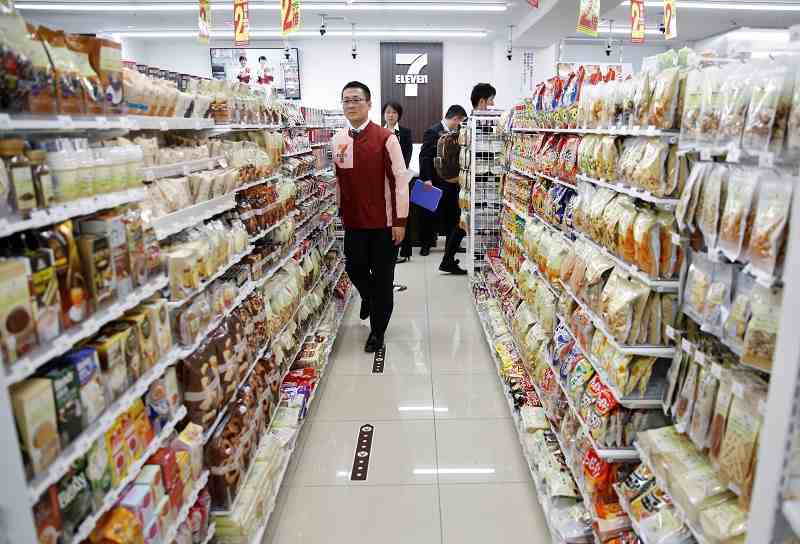
An employee walks at a 7-Eleven convenience store in Tokyo, December 6, 2017.
14:32 JST, September 2, 2021
The recent Olympics has particularly shone a spotlight on Japan’s convenience stores, as foreign media were necessarily confined to getting their food at them, due to COVID-19 restrictions, for their first two weeks in the country. Despite the difficulties of the situation, they waxed rhapsodic about their encounters with this commonplace feature of Japanese life. Everyone, it seemed, had their own favorite food that they were eager to share with the world. I realized I had failed to fully grasp the significance of this daily component of Japanese life.
Shortly after I arrived in Japan in the summer of 1983, one of my Japanese teachers talked to the students in our language class about convenience stores. She was a friendly teacher who often tried to engage us beyond our textbooks, speaking in easy Japanese about various things that might interest us: fireworks, Shinjuku, pop music. But convenience stores? She seemed to be speaking proudly, even excitedly, about the stores. We nodded, and said halfheartedly, “Yeah, convenience stores are … nice.” We were naturally constrained in our responses by our level of Japanese proficiency but much more limited by our lack of vision. We had all come to Japan with the aim of experiencing many aspects of the culture firsthand. But convenience stores were on no one’s must-visit list.
Oh, how times have changed! My teacher’s enthusiasm was not misplaced, although she may have been an early devotee of what a decade later came to be called konbini. Almost 40 years after my teacher, I too found myself feeling rather proud of this cultural marvel that no longer appears banal, in the country that has become my home.
For a long time, I took konbini for granted. A turning point was watching the TBS TV program “Job-tune.” On the show, famous chefs sample culinary creations, give them either a thumbs-up or thumbs-down by raising signs with a circle for “Yes!” or an X for “No!” after making the judgment process as suspenseful as possible, with pursed lips, knitted eyebrows, frowns, and nods as they examine and taste the dishes.
Many of these dishes are earnestly designed for konbini. The TBS website describes a program that aired on July 24 this year as follows: “August 2020 … Challenging the judges with 10 sweets in which they had absolute confidence, Ministop achieved the highest grade in the history of the judges when nine of the items were approved, including one unanimously approved item. They are participating again to solidify their position as the sweets champion! They’ve improved their tiramisu, which was the only one that failed last time, and they’ll try again! The goal is to gain approval of nine products! Aiming for even higher heights, aiming to get a perfect vote for all products! And the judges of these top-class sweets craftsmen will … ??”
Apart from the great food and other functions such as package pickup, ATM, copier, and bill payment, konbini offer something less tangible but more profound, simply in their role as places to go to. Marketing and consumer behavior researcher David Marshall proposes that konbini are lifestyle centers for young people, and, combining “konbini” with “well-being,” he has coined the phrase “well-konbeing.” Marshall asked 453 university students to rate statements like “Shopping at konbini contributes to my overall quality of life,” “Konbini contribute to my social well-being,” and “Konbini play an important role in the community,” on a scale from 1 (strongly agree) to 7 (strongly disagree), and all garnered scores around 3, indicating agreement.
Similarly, sociocultural anthropologist Gavin Whitelaw draws on sociologist Ray Oldenburg’s notion of “third places,” places such as main streets, pubs and post offices that are distinct from “first places,” homes, and “second places,” work, which encourage easygoing communication across social strata. Konbini are not exactly like these third places as Oldenburg describes them, but something akin to them, fulfilling a vital social purpose in Japan. Whitelaw calls them a “place between places,” noting that they are “anonymous, silent, and distancing, but also close, comforting, and possessing a certain affect of their own.” They are places to be, for their own sake, spots to pass through and feel some connection with life’s processes. One young informant of Whitelaw described konbini as “like the air you breathe.”
Surely the protagonist of Sayaka Murata’s Akutagawa-prizewinning novel “Convenience Store Woman,” Keiko Furukura, would concur. Furukura calls convenience stores a “forcibly normalized environment,” which sounds a bit brutal, but also describes her joy each morning as she greets customers who come into her store: “I love this moment. It feels like ‘morning’ itself is being loaded into me. The tinkle of the door chime as a customer comes in sounds like church bells to my ears. When I open the door, the brightly lit box awaits me — a dependable, normal world that keeps turning. I have faith in the world inside the light-filled box.”
A classic New Yorker magazine cartoon created by Mick Stevens portrays a dismal landscape with a bottle, can, tire and pencil lying on their sides, along with some indistinguishable objects, and the caption, “Life Without Mozart.” When I think of life without konbini, it is this image that springs to mind.

Kate Elwood
Elwood is a professor of English at Waseda University’s School of Commerce.
"Business" POPULAR ARTICLE
-

Keidanren Chairman Yoshinobu Tsutsui Visits Kashiwazaki-Kariwa Nuclear Power Plant; Inspects New Emergency Safety System
-

Imports of Rare Earths from China Facing Delays, May Be Caused by Deterioration of Japan-China Relations
-

University of Tokyo Professor Discusses Japanese Economic Security in Interview Ahead of Forum
-

Japan Pulls out of Vietnam Nuclear Project, Complicating Hanoi’s Power Plans
-

Govt Aims to Expand NISA Program Lineup, Abolish Age Restriction
JN ACCESS RANKING
-

Keidanren Chairman Yoshinobu Tsutsui Visits Kashiwazaki-Kariwa Nuclear Power Plant; Inspects New Emergency Safety System
-

Imports of Rare Earths from China Facing Delays, May Be Caused by Deterioration of Japan-China Relations
-

University of Tokyo Professor Discusses Japanese Economic Security in Interview Ahead of Forum
-

Japan Pulls out of Vietnam Nuclear Project, Complicating Hanoi’s Power Plans
-

Govt Aims to Expand NISA Program Lineup, Abolish Age Restriction

























